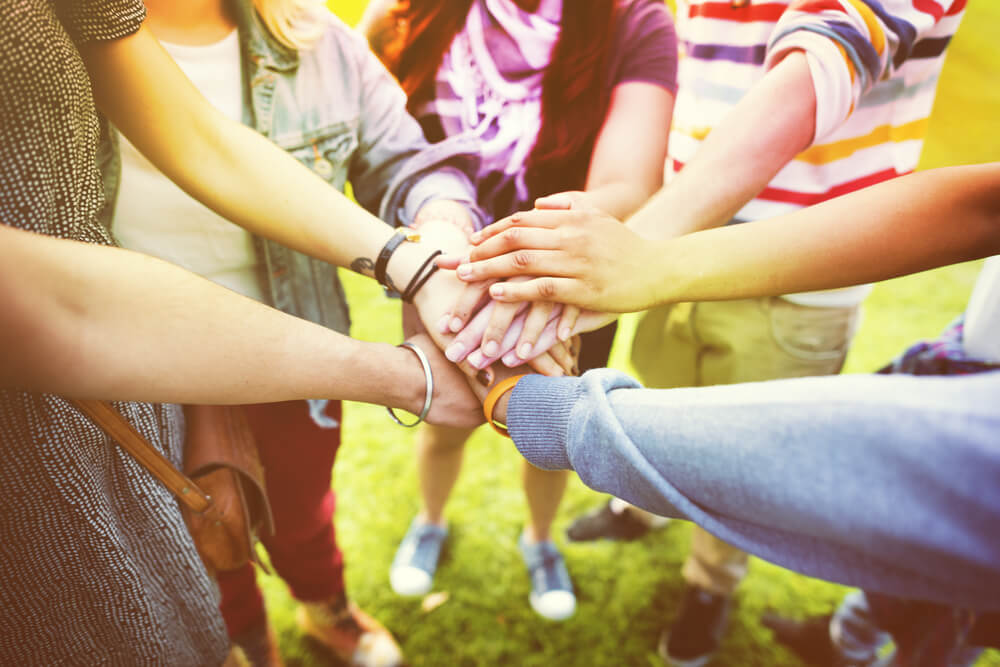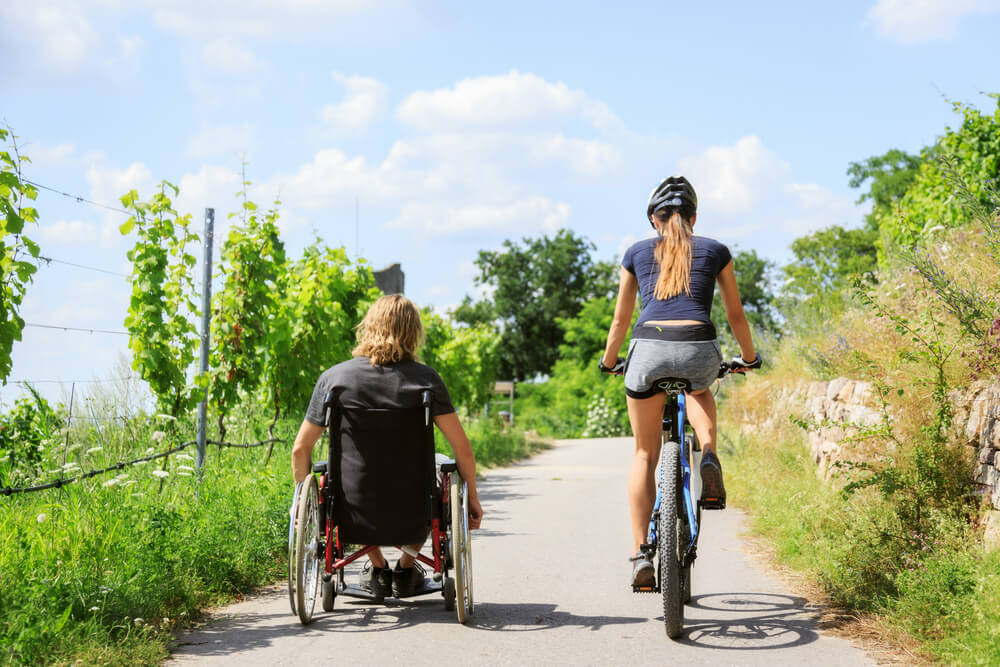Around 61 million people (nearly one in four) people in the United States are living with some sort of disability. But people with disabilities are often excluded from social relationships, community participation, leisure activities, and employment. Community integration for people with disabilities seeks to remedy these disconnects by creating inclusive, diverse societies.
In this blog, we’ll take a closer look at community integration, its many benefits, and how we can work together to create more welcoming communities for everyone.
Table of Contents
What is Community Integration?
As the name suggests, community integration refers to assimilating — and welcoming — people with disabilities into the larger community. Community integration enables persons with disabilities to fully participate in life at the same level as nondisabled individuals. This participation can take place in neighborhoods, schools, workplaces, congregations, community centers, and more.
Community integration for people with disabilities is vitally important to the overall health and wellbeing of a community. In too many cases, persons with disabilities are segregated and kept away from their nondisabled peers. But successful community integration gives people with disabilities a strong community presence without reducing them to their disability label.
What Does Community Integration Include?
Helping people with disabilities enjoy full lives within their communities involves a number of important components. For community integration to be a long-term success, persons with disabilities must have equal access to:
- Citizenship and civic engagement
- Education
- Employment
- Healthcare
- Housing
- Peer support
- Recreation and leisure activities
- Spirituality and religion
- Valued social roles (marriage, parenting, etc.)
Community integration should take place across an individual’s lifespan and be tailored to their stage of life and interests. Regardless of age, people with disabilities should fully understand the many supports and services available to them when it comes to community integration.
Factors That Affect Community Integration
Several key factors affect the ability of people with disabilities to participate in community integration. These include (but are not limited to) the:
- Severity of their disability or impairment
- Accessibility (or lack thereof) of their surroundings
- Availability of assistive technologies and devices
- Underlying cultural and political influences/expectations in their area
- Degree of support from their family and overall community

What is Disability Inclusion?
Inclusion plays a central role in community integration and helping people with disabilities feel fully accepted and welcomed. While persons with disabilities may experience physical inclusion when out in their community, they often don’t feel included socially. And many people with disabilities live, work, and relax with other people with disabilities, causing them to feel even more isolated.
Individuals with disabilities experience true inclusion when they experience feelings of belonging and membership. When both their physical and social presence is accepted and embraced, they can fully participate in significant roles like being a student, employee, spouse, partner, or parent.
Main Components of Disability Inclusion
Disability inclusion shares many of the same characteristics of community integration. To experience full inclusion, people with disabilities must:
- Have the ability to choose from multiple experiences and who they spend time with
- Have a full and equal presence in places where nondisabled individuals are present
- Be recognized for their competencies and have access to learning opportunities
- Be able to fully participate in life, rather than just observe from the sidelines
- Have access to valued roles and be seen as a person, rather than a disability label
- Enjoy environments that are as accessible as possible via universal design
- Have access to reasonable accommodations at school and in the workplace
Impact of the U.S. Supreme Court’s Olmstead Decision
Few legislative actions have impacted community integration for people with disabilities as much as the U.S. Supreme Court’s 1999 Olmstead decision. Olmstead v. L.C. reaffirmed that the unjustified segregation of people with disabilities is a form of discrimination prohibited by Title II of the Americans with Disabilities Act (1990).
Under Title II of the Americans with Disabilities Act (ADA), governmental agencies must give people with disabilities equal access to community integration programs, activities, and supports. In other words, persons with disabilities have the right to receive services in the most integrated community settings possible.
The ADA also asserts that living in an integrated community and making one’s own decisions is a fundamental right of all people. It also helps prevent unnecessary institutionalization and eliminates feelings of isolation and alienation among individuals with disabilities.
Ultimately, the Olmstead decision argued that segregating people with disabilities perpetuates the stereotype that they are “incapable or unworthy of participating in community life.” Additionally, they ruled that segregation and confinement of people with disabilities “severely diminishes [their] everyday life activities…including family relations, social contacts, work options, economic independence, educational advancement, and cultural enrichment.”
Benefits of Community Integration
We’ve already mentioned some of the benefits of community integration for people with disabilities. In this section, we’ll take a closer look at these positives, along with the benefits of integration for the larger community.
Benefits for People with Disabilities
The biggest benefit of community integration for people with disabilities is the opportunity to truly be part of their community. Regardless of disability status, everyone possesses unique talents and abilities and deserves the right to play an active role in society.
Community integration programs keep people with disabilities engaged and provide them with opportunities to learn, work, and play alongside everyone else. Here are a handful of other benefits of community integration for people with disabilities:
- Helps them build practical life skills that lead to enhanced independence
- Provides a path to recovery for those who feel isolated and unwanted
- Gives them access to activities and services not available in segregated environments
- Offers the chance to engage with others and the satisfaction of being part of a diverse community
- Provides the opportunity to learn appropriate social behaviors and make new connections
- Gives access to inclusive workplaces where they’re treated the same as their nondisabled peers

Benefits for the Larger Community
Successful community integration also has a variety of benefits for nondisabled people and the community at large. These include:
- More diverse relationships with those who have different viewpoints and experiences
- More funding for public spending when people with disabilities work and pay taxes
- Decreased costs associated with supporting people with disabilities through paid professionals
- The chance to experience the many gifts and talents people with disabilities possess
Examples of Community Integration Activites
Community integration comes in many forms, and programs typically incorporate a variety of activities, instruction, and services. Here are just a few examples of community integration for people with disabilities:
- Joining community sports leagues
- Taking public transportation
- Joining youth organizations
- Participating in recreation center programs
- Going to plays, concerts, or sporting events
- Visiting museums or historical societies
- Volunteering with charitable organizations
- Joining interest clubs
- Participating in faith communities
- Taking advantage of K-12 extracurriculars
- Visiting neighborhood parks or nature centers
- Joining workplace sports teams
Barriers to Community Integration
Unfortunately, there are several barriers to community integration that can keep people with disabilities on the sidelines. We’ll take a closer look at these obstacles (along with how to overcome them) in the following sections.
Feelings of Devaluation & Marginalization
When people feel viewed more as their disability label than a valuable individual, they’re less likely to participate in community integration. People with disabilities often feel invisible, unwelcome, and like a burden on society. In fact, the stigma of being someone with a disability can be more of a hindrance than one’s actual disability.
Lack of Knowledge & Capabilities
Many people with disabilities aren’t aware of the full range of supports and services available to them. Some have underdeveloped social skills, and many feel crippling anxiety when it comes to community integration. Not understanding their rights (and underestimating their capabilities) prohibits them from taking advantage of every available resource.
Lack of Transportation
The most common practical barrier to community integration is a lack of reliable transportation. People who don’t drive or have access to public transportation are unable to engage in and benefit from activities that promote community integration.
Family Resistance
Many people with disabilities live with and are cared for by members of their immediate family. These family members may be overprotective of their loved ones with a disability, preventing them from participating in community integration programs.
Lack of Funding & Staff Resources
Many organizations that provide community activities do not receive adequate funding. Without enough money, these groups cannot offer the programs and activities that are vital to successful community integration. Additionally, many of them do not have appropriately-trained staff with the capability to fully support clients mentally and emotionally.
Lack of Educational Support & Transition Services
In many areas, there is a significant lack of transition services for young people journeying from high school into adulthood. This can keep them from experiencing (and benefitting from) true community integration. Individualized education programs (IEPs) are required by law to plan for the school-to-career transition well in advance of graduation, but this often doesn’t happen.

Overcoming Barriers to Community Integration
While the barriers to community integration for people with disabilities may feel overwhelming, they don’t have to be. Here are three ways to overcome obstacles to community integration.
Participate in Real-Life Skills Training
One of the best ways to facilitate successful community integration and inclusion is taking advantage of real-life skills training. This can help people with disabilities pinpoint and hone their strengths, identify their interests, and define their vision of success within their community.
Develop Your Self-Determination
In a nutshell, self-determination refers to having control over the facets of one’s life that are most important to them. This includes making informed decisions and understanding how personal choices affect one’s independence. Having full control over one’s own life and the authority to make one’s own choices are two of the best ways to facilitate community integration.
Always Advocate For Yourself
Another way to overcome any potential barriers to community integration is by always being one’s own advocate. While self-advocacy is closely tied to self-determination, it particularly emphasizes speaking up for oneself and advancing one’s rights. Advocating for oneself (and for the rights of others with disabilities) plays a central role in successful community integration.
Enlist the Help of an Occupational Therapist
If you’re interested in community integration for people with disabilities but aren’t sure where to start, consider working with an occupational therapist. Because they’re specially trained to understand interactions between people and their environment, occupational therapists can provide valuable insights for successful community integration.
Your occupational therapist will help you pinpoint and develop your unique skills and abilities and work with you to incorporate them into your daily life. They’ll take an in-depth look at the physical spaces you inhabit and the environmental factors that affect you. Then, they’ll help you develop a plan for success, no matter where you are in your community.
Along with providing valuable training and personal development opportunities, occupational therapists can help you modify activities and environments to best suit your needs. Whether you’re in a group home, assisted living facility, or live on your own, you can benefit from occupational therapy.
Work with Your UDS Care Manager
If you’d rather work with someone you already know (rather than hiring an occupational therapist), your Care Manager can also assist you. Our Care Managers (also known as Service Coordinators) are specially-trained to assess, plan, coordinate, and manage every aspect of your person-centered care plan. We’re also enrolled with all three Pennsylvania Community HealthChoices Managed Care Organizations: AmeriHealth Caritas, PA Health & Wellness, and UPMC Community HealthChoices.